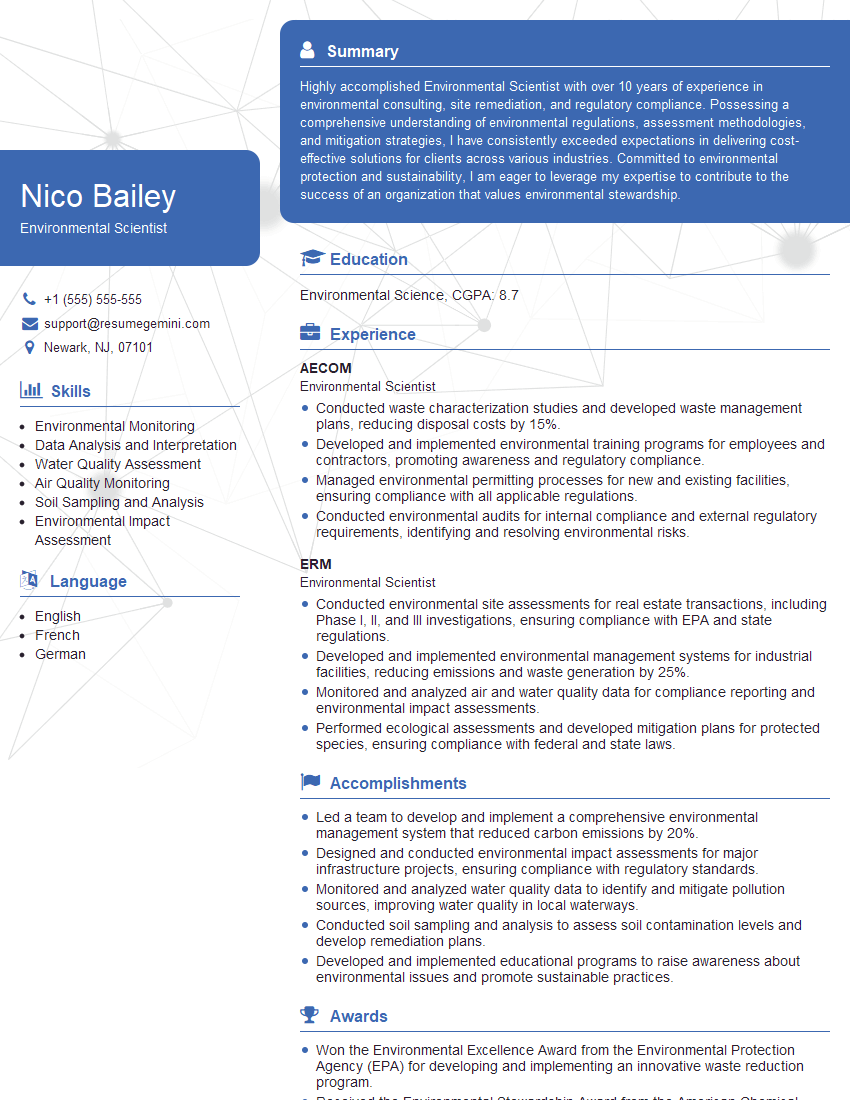Are you ready to stand out in your next interview? Understanding and preparing for Ecological Monitoring and Sampling interview questions is a game-changer. In this blog, we’ve compiled key questions and expert advice to help you showcase your skills with confidence and precision. Let’s get started on your journey to acing the interview.
Questions Asked in Ecological Monitoring and Sampling Interview
Q 1. Describe your experience with various sampling methods for aquatic ecosystems.
My experience with aquatic ecosystem sampling methods is extensive, encompassing various approaches tailored to specific research questions and habitat types. For instance, when assessing benthic macroinvertebrate communities – the small animals living on the bottom – I frequently employ surber samplers, which are frames used to collect organisms from a known area of streambed. The size and shape of the sampler are chosen to fit the habitat and the organisms of interest. For larger, more mobile organisms like fish, electrofishing is a powerful technique. It uses an electric current to temporarily stun fish, allowing for their capture, identification, and measurement before being safely released. For phytoplankton (microscopic plants), water column sampling using a Van Dorn bottle is crucial. This allows for collection of water samples at specific depths to analyze species composition and abundance. Finally, for assessing overall water quality, I utilize integrated water samplers that collect samples across a specified depth range, giving a more representative picture of the water column. The choice of method always depends on the target organisms, the habitat’s characteristics, and the research objectives. For example, in a fast-flowing river, a surber sampler would be more effective than a kick net, which is better suited for slower-moving water.
Q 2. Explain the importance of proper sample preservation and chain of custody.
Proper sample preservation and maintaining a robust chain of custody are absolutely paramount to ensuring data integrity and the validity of any ecological monitoring project. Imagine a detective investigating a crime scene – every piece of evidence must be handled carefully and its location and movement documented. Similarly, ecological samples are delicate. For instance, water samples for nutrient analysis often require immediate refrigeration to prevent biological processes from altering nutrient concentrations. Similarly, macroinvertebrate samples might need to be preserved in alcohol to prevent decomposition. The chain of custody is a detailed record of who handled the sample, when, and where. This includes the time and date of collection, the location, the collector’s name and identification number, storage locations, and the date and time of analysis. Any deviation from the established protocol would raise serious questions about the credibility of the results. A documented and unbroken chain of custody significantly enhances the credibility and defensibility of the data in any subsequent report or publication. Without it, the data is significantly weakened and potentially unusable.
Q 3. How do you ensure data quality and accuracy in ecological monitoring projects?
Ensuring data quality and accuracy is an iterative process starting before any data is even collected. It involves meticulous planning, standardized protocols, rigorous quality control checks, and thorough documentation throughout the entire process. This includes: 1. Careful site selection and replication to represent the ecosystem adequately. 2. Using calibrated instruments and appropriate sampling equipment to minimize measurement error. 3. Employing blind samples and replicate analyses to assess analytical precision and accuracy. 4. Implementing data validation checks to identify outliers and inconsistencies. 5. Maintaining a detailed field notebook that provides context for the collected data. 6. Thoroughly documenting all methods and procedures used so the study is easily repeatable by others. For instance, if we are measuring water temperature, we will use calibrated thermometers and take multiple measurements at each site. We would also compare these measurements with those from a reference thermometer or sensor. These measures help in minimizing random and systematic errors, ultimately enhancing the reliability of the findings.
Q 4. What statistical methods are you familiar with for analyzing ecological data?
My statistical toolkit includes a wide range of methods tailored to analyze ecological data, many of which are non-parametric. For analyzing community composition, I use multivariate techniques like Principal Component Analysis (PCA) and Non-metric Multidimensional Scaling (NMDS). These methods are particularly useful for visualizing patterns in complex datasets with many species. When examining changes in species abundance over time or across different sites, I often apply time series analysis and ANOVA or Kruskal-Wallis tests to identify significant differences. For analyzing relationships between species and environmental variables, I use correlation analysis and regression models. In the case of count data, particularly abundance data, generalized linear models (GLMs) with Poisson or negative binomial distributions are frequently employed. The choice of statistical approach depends heavily on the data type (continuous, categorical, count), assumptions of the data distribution, and the specific research question. For example, if I’m examining how fish species richness changes along a pollution gradient, I might use a regression model; but if I am comparing fish communities in two different lakes, a non-parametric multivariate analysis might be more suitable.
Q 5. Describe your experience with GIS software in the context of ecological mapping.
My experience with GIS software, primarily ArcGIS and QGIS, is extensive and crucial to my ecological work. I use it for a wide range of applications in ecological mapping, including creating and manipulating spatial datasets, visualizing data geographically, and conducting spatial analysis. For instance, I use GIS to create species distribution maps, overlay habitat data with environmental variables, assess habitat fragmentation, and model species spread and connectivity. I have also used GIS to design effective sampling strategies by identifying optimal locations for data collection based on spatial patterns of habitat type or environmental factors. GIS is integral to making ecological data spatially explicit, allowing me to move beyond simple tabular data and visualize patterns in relation to the landscape. Imagine trying to understand the impact of deforestation on a bird species without a map – it’s nearly impossible! GIS allows us to integrate different layers of information such as vegetation type, topography, and land use, adding vital context to our analyses.
Q 6. How do you handle missing data in an ecological dataset?
Handling missing data is a critical aspect of ecological data analysis, and ignoring it can bias results. There are several approaches, each with its own implications. Simple deletion, while straightforward, can lead to substantial loss of information and bias if missing data are not randomly distributed. Imputation, where missing values are estimated based on available data, is a more sophisticated method. Common imputation techniques include mean imputation (replacing with the average), multiple imputation (generating multiple plausible values), or using more sophisticated statistical methods like k-nearest neighbors imputation. The choice of imputation method depends on the characteristics of the missing data and the specific analysis. It is crucial to fully describe the method of handling missing data in any publication or report, and be aware that imputation is not a perfect solution. The best approach frequently involves a combination of identifying and mitigating the causes of missing data during the field work stage and then using appropriate imputation or analysis techniques to account for remaining missing values in the data analysis phase.
Q 7. What are the limitations of your preferred sampling method?
While I find electrofishing to be a highly effective method for sampling fish communities in many aquatic ecosystems, it does have limitations. First, it is not suitable for all species or habitats. It’s less effective in very shallow or deep waters, or among densely vegetated areas. Some species, such as those with specialized habitats or highly sensitive electroreception, may avoid or be particularly susceptible to the electric current. This could lead to an underestimation of their abundance. Second, electrofishing can cause stress or mortality to fish, although this can be minimized with proper techniques and rapid handling. Third, the catch efficiency of electrofishing – the proportion of fish actually caught compared to the total number present – can vary depending on factors like water conductivity, substrate type, and operator skill. Therefore, it is important to acknowledge these limitations when designing a study and interpreting the results. To mitigate some of these issues, careful site selection, standardized electrofishing protocols, and multiple sampling efforts are necessary.
Q 8. Explain your understanding of different ecological indices and their applications.
Ecological indices are standardized metrics used to assess the health and integrity of an ecosystem. They synthesize complex ecological data into easily interpretable scores, allowing for comparisons across different sites, times, or treatments. Different indices focus on various aspects of ecosystem function and structure.
Diversity Indices (e.g., Shannon-Wiener, Simpson): These measure the species richness and evenness within a community. A higher index value generally suggests a healthier, more resilient ecosystem. For example, a high Shannon-Wiener index in a forest indicates a greater variety of tree species, suggesting greater stability and resistance to disturbances.
Biotic Indices (e.g., BMWP, ASPT): These use the presence and abundance of specific indicator species (species sensitive to pollution or habitat degradation) to assess water or soil quality. For instance, the presence of mayfly nymphs (sensitive to pollution) in a stream indicates good water quality, whereas the dominance of pollution-tolerant species like sludge worms suggests degradation.
Trophic Indices: These examine the structure of food webs, evaluating the balance between different trophic levels (producers, consumers, decomposers). Changes in these indices might signal ecosystem imbalances, such as overgrazing or nutrient pollution.
The choice of index depends on the specific research question, the ecosystem being studied, and the available data. For example, when assessing the impact of a dam on a river ecosystem, one might use both diversity indices to measure changes in fish communities and biotic indices to assess the water quality downstream.
Q 9. Describe your experience with different types of ecological monitoring equipment.
My experience encompasses a wide range of ecological monitoring equipment, from basic tools to sophisticated technologies. This includes:
Field Equipment: GPS units for precise location mapping, quadrats and transects for vegetation surveys, pitfall traps and insect nets for invertebrate sampling, water quality meters (measuring dissolved oxygen, pH, temperature, conductivity), sediment samplers, and various tools for soil sampling.
Remote Sensing Technologies: I’ve worked extensively with aerial imagery and LiDAR (Light Detection and Ranging) data to map habitat types and assess forest cover changes. Satellite imagery provides broader spatial coverage for long-term monitoring programs.
Acoustic Monitoring: For aquatic environments, I have utilized hydrophones and echo sounders to monitor fish populations and their behavior. This is particularly useful for assessing the abundance and distribution of elusive species.
Laboratory Equipment: My experience includes using microscopes for identifying organisms, spectrometers for water chemistry analysis, and various instruments for analyzing soil and tissue samples.
The choice of equipment depends heavily on the study design, the specific research questions, and the resources available. For instance, a small-scale vegetation survey might only require quadrats and a GPS, while a large-scale biodiversity assessment could involve aerial imagery and acoustic monitoring.
Q 10. How do you determine the appropriate sample size for an ecological study?
Determining the appropriate sample size is crucial for obtaining statistically robust results in ecological studies. A sample size that is too small may lead to inaccurate conclusions, while an excessively large sample size can be inefficient and costly. The optimal sample size depends on several factors:
Study objectives: The precision required for estimating population parameters (e.g., species abundance, community composition) influences sample size. More precise estimates require larger sample sizes.
Species abundance and distribution: Rare species require larger sample sizes to ensure sufficient detection. Species with highly clumped distributions also require more samples to adequately represent the population.
Study area heterogeneity: If the study area is highly variable, a larger sample size is necessary to capture the variability and avoid bias.
Statistical power: Power analysis is a statistical method used to determine the minimum sample size needed to detect a meaningful difference or effect with a specified level of confidence (e.g., 80% power, 5% significance level).
Software packages like R or Power Analyst are used for power analysis. In practice, I often employ a combination of pilot studies (small-scale preliminary surveys) and power analysis to determine the most appropriate sample size for a specific project.
Q 11. What are some common challenges in ecological monitoring and how do you overcome them?
Ecological monitoring faces numerous challenges. Some of the most common include:
Temporal and Spatial Variability: Ecosystems are dynamic, and conditions can change rapidly. This makes it challenging to obtain consistent data over time and across different locations. We address this through careful experimental design, including replication and randomization of sampling locations, and the use of long-term monitoring programs to capture natural fluctuations.
Logistical Constraints: Remote or difficult-to-access locations can significantly impact data collection. Careful planning, appropriate equipment, and potentially the use of remote sensing technologies are vital to overcome these logistical hurdles.
Data Analysis and Interpretation: Ecological datasets are often complex and require advanced statistical techniques for interpretation. The use of appropriate statistical software and collaboration with statisticians is essential.
Funding Limitations: Ecological monitoring is often resource-intensive. Securing adequate funding for long-term monitoring and the appropriate technology is a persistent challenge. This often requires careful grant writing and justification of the long-term value of the study.
Unforeseen Events: Unexpected events such as extreme weather events, human disturbances, or invasive species can significantly impact data quality and interpretation. Adaptability and contingency planning are key here.
Overcoming these challenges involves careful planning, meticulous data collection, and the application of appropriate statistical methods. Collaboration with other scientists and stakeholders, as well as adapting strategies as needed, are crucial for successful ecological monitoring.
Q 12. Explain the difference between qualitative and quantitative ecological data.
Ecological data can be broadly categorized as qualitative or quantitative:
Qualitative Data: This describes the qualities or characteristics of an observation. It is often descriptive and non-numerical. Examples include habitat descriptions (e.g., ‘dense forest,’ ‘rocky shoreline’), species observations (e.g., ‘presence of bald eagles’), or behavioral observations (e.g., ‘aggressive interactions between individuals’). Qualitative data provides valuable context and can be used to generate hypotheses for further investigation.
Quantitative Data: This involves numerical measurements and counts. Examples include species abundance (e.g., ’25 oak trees’), plant height (e.g., ‘1.5 meters’), water temperature (e.g., ’22°C’), or pollution levels (e.g., ’10 ppm nitrate’). Quantitative data allows for statistical analysis and is essential for drawing rigorous conclusions.
Often, ecological studies benefit from a mixed-methods approach, combining both qualitative and quantitative data to provide a comprehensive understanding of the system. For example, a study on the impact of a wildfire on a forest might include quantitative data on tree mortality rates alongside qualitative data on changes in habitat structure and species composition.
Q 13. Describe your experience with environmental regulations related to ecological monitoring.
My work regularly involves navigating environmental regulations related to ecological monitoring. I am familiar with various national and international regulations and guidelines, including:
Endangered Species Act (ESA): This act protects threatened and endangered species, and my work often involves assessing habitat suitability and population trends for listed species, ensuring compliance with ESA requirements.
Clean Water Act (CWA): This act regulates water pollution, and I have experience conducting ecological monitoring to assess water quality and compliance with CWA standards. This often involves analyzing biotic indices and water chemistry data.
National Environmental Policy Act (NEPA): This requires environmental impact assessments for major projects, and my expertise is frequently utilized to assess the potential ecological consequences of proposed developments.
My understanding of these and other regulations ensures that ecological monitoring projects are designed, implemented, and reported in accordance with legal requirements. This includes proper permitting, sampling protocols, data reporting, and documentation.
Q 14. How do you ensure the ethical considerations of your ecological monitoring work?
Ethical considerations are paramount in ecological monitoring. My approach emphasizes:
Minimizing disturbance to ecosystems: I employ non-invasive sampling techniques whenever possible, aiming to minimize the impact on the organisms and habitats being studied. For instance, using remote sensing instead of destructive sampling methods.
Data integrity and transparency: I ensure accurate and objective data collection and reporting. All data are carefully documented, and any limitations or potential biases are clearly acknowledged. Raw data and analysis methods are made available to ensure reproducibility.
Respect for Indigenous knowledge and rights: When working in areas with Indigenous communities, I always ensure that their rights and traditional ecological knowledge are respected and incorporated into the monitoring process. This often involves engaging with local communities and obtaining their free, prior, and informed consent.
Animal welfare: When animal handling is necessary, I adhere to strict ethical guidelines and obtain the necessary permits and approvals. This involves minimizing stress and ensuring the humane treatment of animals.
Data sharing and collaboration: I believe in open data sharing and collaboration with other researchers and stakeholders to ensure that the findings from ecological monitoring contribute to broader scientific understanding and conservation efforts. This strengthens the scientific community and ensures the impact of the data transcends any one project.
Adherence to these ethical principles is vital to ensure the credibility and sustainability of ecological monitoring efforts and to promote responsible research practices.
Q 15. How do you communicate complex ecological data to non-technical audiences?
Communicating complex ecological data to non-technical audiences requires translating scientific jargon into plain language, using visuals, and focusing on the story behind the data. Think of it like translating a scientific paper into a compelling narrative.
For instance, instead of saying “The species richness index decreased by 1.2 units, indicating a potential decline in biodiversity,” I might say, “We found fewer different kinds of plants and animals in this area than before, suggesting a loss of biodiversity. This could be because…” I would then use charts, graphs, and perhaps even photos to illustrate the changes.
I frequently use analogies to make concepts relatable. For example, when discussing population dynamics, I might compare a population’s growth to compound interest or the spread of a disease. Storytelling is key; connecting the data to a broader context (e.g., the impact on local communities or ecosystem services) makes it more engaging and memorable.
Finally, I always tailor my communication style to the audience. A presentation to a group of landowners will differ significantly from a presentation to school children. Interactive elements, like Q&A sessions, are crucial for ensuring understanding and fostering engagement.
Career Expert Tips:
- Ace those interviews! Prepare effectively by reviewing the Top 50 Most Common Interview Questions on ResumeGemini.
- Navigate your job search with confidence! Explore a wide range of Career Tips on ResumeGemini. Learn about common challenges and recommendations to overcome them.
- Craft the perfect resume! Master the Art of Resume Writing with ResumeGemini’s guide. Showcase your unique qualifications and achievements effectively.
- Don’t miss out on holiday savings! Build your dream resume with ResumeGemini’s ATS optimized templates.
Q 16. Describe your experience with data management and analysis software.
My experience with data management and analysis software is extensive. I am proficient in R, Python (with packages like Pandas and Scikit-learn), and ArcGIS. R is my go-to for statistical analysis, particularly for complex ecological modeling and multivariate analyses. For instance, I’ve used vegan package in R to perform ordination techniques (like NMDS) to visualize community composition data and identify key environmental gradients influencing species distribution.
Python is excellent for data cleaning, preprocessing, and machine learning applications. I’ve used it to build predictive models for invasive species spread, employing algorithms like Random Forests. ArcGIS is essential for spatial data analysis and mapping, allowing me to integrate ecological data with geographic information to create informative maps showing species distributions, habitat suitability, or the impact of land-use change.
Beyond these, I am experienced with database management systems such as SQL and have experience using cloud-based platforms for data storage and collaboration. Data quality control and version control are paramount in my workflow. I always document my analytical procedures meticulously, ensuring reproducibility and transparency.
Q 17. How do you assess the success of an ecological restoration project?
Assessing the success of an ecological restoration project requires a multifaceted approach, going beyond simply observing plant growth. We need to establish clear, measurable objectives before the project even begins.
- Baseline Data: Before restoration begins, we collect extensive baseline data on the site’s ecological condition. This includes species composition, soil properties, water quality, and other relevant parameters.
- Monitoring Plan: A robust monitoring plan is crucial, specifying the metrics to be measured (e.g., plant cover, species richness, water quality parameters), sampling methods, frequency of sampling, and statistical analysis techniques.
- Comparison with Controls: We often include control sites (unrestored areas) to allow us to compare the restored area’s progress against a reference point.
- Adaptive Management: Ecological restoration is an iterative process. Regular monitoring allows us to assess whether the project is on track and make adjustments as needed. For example, we might need to adjust planting strategies or control invasive species more aggressively if the restoration isn’t progressing as expected.
Ultimately, success is determined by whether the restoration project achieves its pre-defined ecological goals and objectives within a reasonable timeframe. This often involves comparing post-restoration data to the baseline data and control sites, using appropriate statistical tests to determine if significant changes have occurred.
Q 18. What is your experience with different types of ecological surveys?
My experience encompasses a wide range of ecological surveys, tailored to the specific research question and ecosystem. These include:
- Vegetation Surveys: Using various sampling methods like quadrats, transects, and point intercept to assess plant species composition, abundance, and diversity. I’ve used these in diverse settings, from forests to grasslands to wetlands.
- Wildlife Surveys: Employing methods like camera trapping, track surveys, point counts, and mark-recapture techniques to assess animal populations, distributions, and habitat use. My work has included surveys of birds, mammals, reptiles, and amphibians.
- Aquatic Surveys: I’m experienced in conducting aquatic surveys using methods such as benthic macroinvertebrate sampling, water quality testing, and fish surveys (e.g., electrofishing).
- Soil Surveys: Assessing soil properties, including nutrient levels, pH, and organic matter content, to understand their influence on plant communities and overall ecosystem health.
The choice of survey method depends heavily on factors such as the target species, available resources, and the study’s objectives. I always strive to employ statistically sound sampling designs to ensure the data is representative and allows for meaningful analysis.
Q 19. Describe your knowledge of relevant environmental legislation and permitting.
My knowledge of relevant environmental legislation and permitting is comprehensive. I am familiar with the Endangered Species Act (ESA), the Clean Water Act (CWA), the National Environmental Policy Act (NEPA), and other state and local regulations related to environmental protection and ecological conservation. Understanding these regulations is paramount to conducting ecological research and restoration projects legally and ethically.
For example, before initiating any field work that may impact endangered or threatened species or their habitats, I ensure that we obtain the necessary permits from the relevant authorities. I’m also adept at preparing environmental assessments and impact statements as needed for project proposals. This includes understanding the process of navigating environmental review, engaging in stakeholder consultations, and addressing potential environmental concerns proactively.
Staying up-to-date with evolving legislation and case law is a continuous process. I regularly review updates to ensure our work remains compliant and that we are incorporating best practices for environmental stewardship.
Q 20. What are the key factors to consider when designing an ecological monitoring program?
Designing an effective ecological monitoring program requires careful consideration of several key factors:
- Clear Objectives: Define specific, measurable, achievable, relevant, and time-bound (SMART) objectives. What are you trying to monitor and why?
- Study Design: Choose appropriate sampling methods, spatial and temporal scales, and statistical analysis techniques to answer your research questions.
- Data Collection Methods: Select methods that are reliable, efficient, and appropriate for the ecosystem and target species. Consider the feasibility of data collection within the available budget and time frame.
- Data Management: Develop a robust data management system to ensure data quality, accuracy, and accessibility. This includes establishing clear protocols for data entry, storage, and analysis.
- Resource Availability: Account for financial resources, personnel, and equipment needed to conduct the monitoring program successfully.
- Stakeholder Engagement: Involve relevant stakeholders in the design and implementation of the program to ensure that the results are useful and relevant to their needs.
- Adaptive Management: Build flexibility into the program to allow for adjustments based on new information or changes in the system being monitored.
A poorly designed monitoring program can waste valuable resources and fail to provide useful information. A well-designed program, however, can provide crucial insights into ecosystem health, allowing for timely interventions and effective management decisions.
Q 21. How do you ensure the safety of yourself and your team during field work?
Ensuring the safety of myself and my team during fieldwork is a top priority. We adhere to a strict safety protocol that addresses potential hazards in diverse environments.
- Risk Assessment: Before each field trip, we conduct a thorough risk assessment to identify potential hazards, such as venomous animals, hazardous terrain, extreme weather conditions, and potential exposure to harmful substances.
- Safety Training: All team members receive training on safe field practices, including first aid, wilderness survival techniques, and the use of safety equipment.
- Emergency Preparedness: We always carry a comprehensive first-aid kit, satellite communication devices (or at least a well-charged cell phone with a backup plan), and a detailed emergency plan including contact information and evacuation procedures.
- Personal Protective Equipment (PPE): We use appropriate PPE, such as sturdy footwear, insect repellent, sunscreen, and protective clothing, based on the specific environmental conditions and potential hazards.
- Working in Pairs or Teams: We avoid working alone, always working in pairs or teams to ensure mutual support and assistance in case of an emergency.
- Weather Monitoring: We closely monitor weather forecasts and postpone field trips if necessary to avoid hazardous weather conditions.
Our commitment to safety extends beyond the immediate team; we also take steps to minimize environmental impact during fieldwork, adhering to Leave No Trace principles.
Q 22. Describe your experience with different types of habitat assessments.
Habitat assessments are crucial for understanding the ecological integrity of an area. My experience encompasses a wide range of methods, tailored to specific habitat types and research questions. I’ve conducted assessments in forests, wetlands, grasslands, and riparian zones, using various techniques.
- Rapid assessments: These involve quick surveys to get a general overview of the habitat’s condition, often using standardized checklists for vegetation and wildlife. For example, I used a rapid assessment protocol to evaluate the impact of a wildfire on a grassland ecosystem, focusing on key indicator species and vegetation cover.
- Detailed vegetation surveys: These are more in-depth, involving quadrat sampling (measuring plant species composition and abundance within defined areas), species lists, and detailed mapping. I’ve used this approach to monitor changes in forest composition over time, looking at the effects of invasive species or forest management practices.
- Wildlife surveys: Techniques include direct observation (e.g., bird counts, mammal trapping), indirect methods (e.g., scat analysis, track plates), and camera trapping. For instance, I’ve used camera trapping to monitor small mammal populations in a wetland area and assessed the impact of habitat restoration on their diversity.
- Soil sampling and analysis: This involves assessing soil properties (e.g., pH, nutrient levels, organic matter) to understand habitat quality. I once used this method to analyze the impact of agricultural runoff on a riparian zone, studying changes in soil composition and its consequences for plant communities.
The choice of methods depends heavily on the research question, available resources, and the characteristics of the habitat itself.
Q 23. What is your understanding of biodiversity indices and their calculation?
Biodiversity indices are mathematical measures that summarize the diversity of species within a habitat. They provide a quantitative way to compare biodiversity across different sites or over time. Several indices exist, each focusing on different aspects of biodiversity.
- Species richness (S): The simplest index, representing the total number of species present. It’s easy to calculate but doesn’t account for the abundance of each species.
- Shannon diversity index (H): Considers both species richness and evenness (the relative abundance of each species). A higher H value indicates greater diversity. The formula is:
H = -Σ (pi * ln pi), where pi is the proportion of individuals belonging to species i. - Simpson’s diversity index (D): Measures the probability that two randomly selected individuals will belong to different species. A higher D value indicates greater diversity. The formula is:
D = 1 - Σ (pi^2)
Choosing the appropriate index depends on the research question. For example, if you’re interested in the overall richness of species, species richness would be a suitable choice. If you need to account for the relative abundances as well, the Shannon or Simpson index would be more informative. The calculation usually involves field data, like species counts in quadrats or transects.
Q 24. Explain how you would adapt your sampling strategy for different habitats (e.g., forest vs. wetland).
Sampling strategies must be adapted to suit different habitats because of variations in species distribution, accessibility, and environmental factors.
- Forest: In a forest, sampling might involve establishing transects (linear paths) along which quadrats are placed to assess vegetation composition. For fauna, line transects or point counts for birds, or trapping for mammals, could be employed. Considering the stratified nature of forests (understory, canopy, etc.), a multi-tiered sampling approach might be necessary.
- Wetland: Wetlands present unique challenges. Sampling might involve using stratified random sampling across different wetland zones (e.g., emergent vegetation, open water). Vegetation sampling could use quadrats, while fauna could be assessed using pitfall traps, dip nets (for aquatic invertebrates), or visual surveys. Accessibility constraints might necessitate the use of boats or wading gear.
The key is to ensure adequate sample size and replication to minimize sampling error and bias, which is particularly challenging in diverse habitats. For example, a larger sample size would be required in a heterogeneous forest compared to a relatively uniform grassland.
Q 25. How do you ensure the long-term sustainability of an ecological monitoring program?
Long-term sustainability of an ecological monitoring program hinges on several key factors.
- Standardized protocols: Consistent methods ensure data comparability over time. This includes using the same sampling techniques, equipment, and data analysis procedures throughout the program’s duration.
- Data management and storage: A robust system for data storage and retrieval is essential. This includes using appropriate databases, metadata management, and data backups to ensure data integrity and accessibility.
- Funding security: Securing long-term funding through grants, collaborations, or institutional support is critical for maintaining the program’s continuity.
- Personnel training and retention: Investing in training and retaining experienced personnel ensures the program’s expertise and consistency.
- Adaptive management: The program should be flexible enough to adapt to new scientific understanding, technological advancements, and changing environmental conditions.
- Stakeholder engagement: Involving stakeholders (e.g., land managers, policymakers, local communities) ensures the relevance and impact of the monitoring program.
A well-planned program with these elements in place is more likely to provide valuable long-term insights into ecological changes.
Q 26. What are the potential biases associated with different sampling methods?
Various sampling methods can introduce biases. Understanding these biases is crucial for interpreting results accurately.
- Observer bias: Subjectivity in identifying or counting organisms can affect results. Standardized protocols and multiple observers can mitigate this.
- Sampling bias: The choice of sampling location or method can systematically exclude certain areas or species. Random sampling and stratified random sampling can reduce this bias.
- Detection bias: Certain species may be harder to detect than others, leading to underestimation of their abundance. Using multiple detection methods can improve detection rates.
- Edge effect bias: In habitat fragmentation studies, the unique conditions at habitat edges might lead to skewed results unless specifically considered.
For example, using only visual counts for bird surveys may underrepresent nocturnal or cryptic species. Utilizing a combination of methods, including mist netting or acoustic surveys, would help reduce this bias.
Q 27. How would you handle a situation where your sampling results contradict your hypothesis?
When sampling results contradict a hypothesis, it’s essential to systematically investigate possible explanations. This is a crucial part of the scientific process.
- Re-examine the methodology: Check for errors in sampling design, data collection, or data analysis. Were sample sizes adequate? Were there any biases introduced?
- Consider alternative hypotheses: Develop new hypotheses that could explain the observed results. Are there confounding factors that weren’t initially considered?
- Consult existing literature: Review relevant research to see if other studies have encountered similar findings or if there are alternative interpretations of the results.
- Conduct further investigation: Collect additional data to either support or refute the original hypothesis or the new alternative hypotheses. This might involve adjusting the sampling strategy or collecting data from different sites or times.
- Report findings transparently: Clearly state the discrepancies between the hypothesis and results and provide potential explanations for the findings.
It’s crucial to be objective and not to dismiss unexpected results. They often lead to valuable new insights and a deeper understanding of the ecological processes involved.
Q 28. Explain your experience with remote sensing techniques for ecological monitoring.
Remote sensing techniques offer powerful tools for large-scale ecological monitoring. My experience includes using various satellite and aerial imagery data for several applications.
- Vegetation indices (e.g., NDVI): These indices derived from multispectral imagery provide information about vegetation health and productivity. I’ve used NDVI data to monitor deforestation rates, assess the impact of drought on vegetation, and map vegetation types across large landscapes.
- Habitat mapping: High-resolution imagery can be used to map different habitats and assess their extent and distribution. This allows for monitoring changes in habitat area or fragmentation over time. For example, I used LiDAR data to create detailed 3D models of forest structure, enabling the assessment of forest canopy density and biodiversity.
- Wildlife monitoring: Remote sensing techniques are being increasingly used to detect and track animals, particularly larger mammals or birds. This may involve using thermal imaging or object detection algorithms to analyze imagery from drones or satellites. This can help understand animal movements and habitat use.
It’s crucial to remember that remote sensing data needs to be interpreted carefully. Ground truthing (field validation) is essential to ensure accuracy and reliability. For example, I’ve conducted fieldwork to ground-truth my remote sensing-derived forest cover maps, ensuring that the mapped areas accurately reflect actual forest vegetation on the ground.
Key Topics to Learn for Ecological Monitoring and Sampling Interview
- Sampling Design & Techniques: Understanding different sampling methods (e.g., random, stratified, systematic), their strengths and weaknesses, and their appropriate application in various ecological contexts. Consider the impact of sample size and spatial scale.
- Data Collection & Management: Mastering field data collection protocols, ensuring data accuracy and integrity, using appropriate equipment (e.g., GPS, water quality meters), and employing efficient data management strategies (e.g., spreadsheets, databases).
- Statistical Analysis & Interpretation: Familiarity with descriptive and inferential statistics relevant to ecological data. Knowing how to test hypotheses, visualize data, and draw meaningful conclusions from your findings is crucial.
- Specific Ecosystem Monitoring: Gain expertise in monitoring specific ecosystems relevant to your target roles (e.g., aquatic, terrestrial, or forest ecosystems). Understand the unique challenges and methods involved in each.
- Data Reporting & Communication: Develop skills in presenting your findings clearly and concisely through reports, presentations, and visualizations. Practice communicating complex information to both technical and non-technical audiences.
- Regulatory Compliance & Ethical Considerations: Understand relevant environmental regulations and ethical guidelines related to ecological monitoring and sampling. This includes permitting, data handling, and minimizing environmental impact.
- Problem-Solving & Troubleshooting: Develop your ability to identify and resolve challenges encountered during fieldwork, such as equipment malfunctions, unexpected weather conditions, or data inconsistencies. Showcase your critical thinking skills.
Next Steps
Mastering Ecological Monitoring and Sampling opens doors to rewarding careers with significant impact on environmental conservation and management. To stand out, create an ATS-friendly resume that highlights your skills and experience effectively. ResumeGemini is a trusted resource to help you build a professional and impactful resume that showcases your qualifications. We offer examples of resumes tailored to Ecological Monitoring and Sampling positions to help you create a compelling application. Invest time in crafting a strong resume—it’s your first impression on potential employers.
Explore more articles
Users Rating of Our Blogs
Share Your Experience
We value your feedback! Please rate our content and share your thoughts (optional).
What Readers Say About Our Blog
Hi, I have something for you and recorded a quick Loom video to show the kind of value I can bring to you.
Even if we don’t work together, I’m confident you’ll take away something valuable and learn a few new ideas.
Here’s the link: https://bit.ly/loom-video-daniel
Would love your thoughts after watching!
– Daniel
This was kind of a unique content I found around the specialized skills. Very helpful questions and good detailed answers.
Very Helpful blog, thank you Interviewgemini team.










